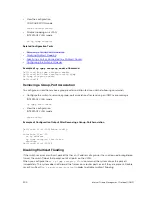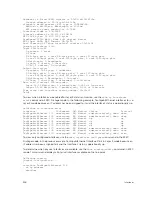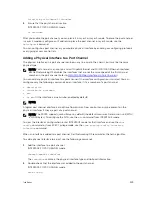
Default Behavior:
Route lookup is done in the default routing table and appropriate egress port is
selected.
Protocol
Behavior when EIS is Enabled
Behavior when EIS is Disabled
ftp
EIS Behavior
Default Behavior
http
EIS Behavior
Default Behavior
ssh
EIS Behavior
Default Behavior
Snmp (snmp mib response)
EIS Behavior
Default Behavior
telnet
EIS Behavior
Default Behavior
icmp (ping and traceroute)
EIS Behavior for ICMP
Default Behavior
Interworking of EIS With Various Applications
Stacking
• The management EIS is enabled on the master and the standby unit.
• Because traffic can be initiated from the Master unit only, the preference to management EIS table for
switch-initiated traffic and all its related ARP processing is done in the Master unit only.
• ARP-related processing for switch-destined traffic is done by both master and standby units.
VLT
VLT feature is for the front-end port only. Because this feature is specific to the management port, this
feature can coexist with VLT and nothing specific needs to be done in this feature to handle VLT scenario.
DHCP
• If DHCP Client is enabled on the management port, a management default route is installed to the
switch.
• If management EIS is enabled, this default route is added to the management EIS routing table and the
default routing table.
ARP learn enable
• When ARP learn enable is enabled, the switch learns ARP entries for ARP Request packets even if the
packet is not destined to an IP configured in the box.
• The ARP learn enable feature is not applicable to the EIS routing table. It is applicable to the default
routing table only to avoid unnecessary double ARP entries
Sflow
sFlow management application is supported only in standalone boxes and switch shall throw error
message if sFlow is configured in stacking environment
314
Internet Group Management Protocol (IGMP)
Summary of Contents for Z9000
Page 1: ...Dell Configuration Guide for the Z9000 System 9 7 0 0 ...
Page 80: ...grub reboot 80 Management ...
Page 128: ... 0 Te 1 1 Te 1 2 rx Flow N A N A 128 Access Control Lists ACLs ...
Page 491: ...Figure 70 Configuring OSPF and BGP for MSDP Multicast Source Discovery Protocol MSDP 491 ...
Page 496: ...Figure 73 MSDP Default Peer Scenario 1 496 Multicast Source Discovery Protocol MSDP ...
Page 497: ...Figure 74 MSDP Default Peer Scenario 2 Multicast Source Discovery Protocol MSDP 497 ...
Page 498: ...Figure 75 MSDP Default Peer Scenario 3 498 Multicast Source Discovery Protocol MSDP ...
Page 760: ...Figure 100 Single and Double Tag TPID Match 760 Service Provider Bridging ...
Page 761: ...Figure 101 Single and Double Tag First byte TPID Match Service Provider Bridging 761 ...
















































